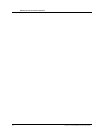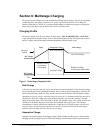
Prosine 2.5/3.0 Installation & Operation Guide 61
Section 6: Multistage Charging
Operation in Charger Mode
WARNING Explosion hazard: During charging, the battery may generate potentially explosive gases.
Follow all the Important Safety Instructions that start on page i. Ventilate the area around the battery
thoroughly and ensure that there are no sources of flame or sparks in the vicinity.
Study all battery manufacturer’s specific precautions such as removing or not removing cell caps
while charging and recommended rates of charge. When using a non-sealed battery, before charging
add distilled water in each cell until electrolyte level reaches the level specified by battery
manufacturer. This helps purge excessive gases from cells. Do not overfill. For a battery without cell
caps, carefully follow manufacturer’s recharging instructions.
If AC power is available, upon system power-up, the unit will begin charging. If AC power is not
available the charger will automatically enter into STANDBY mode. If the inverter mode is not
enabled then the charger STANDBY LED will turn off after a few seconds as the unit enters low
power-draw sleep mode. If the inverter mode is enabled and the unit is inverting, when AC power
becomes available the unit automatically switches from inverter mode to charger mode after an 8
second delay. This delay gives the AC source time to stabilize. The Prosine inverter/charger senses the
battery state and the appropriate charge is delivered to the batteries. During charging, the charging
current will be indicated by the current bar graph on the Prosine inverter/charger control panel. As the
battery charges and the end of the charge cycle nears, the charging current will decrease and
eventually the READY LED will come on. This indicates that Prosine inverter/charger is now in Float
mode and will maintain the battery’s charge as long as AC is supplied to the Prosine inverter/charger.
Operation in Equalization Mode
Follow your battery manufacturer’s recommendations for equalizing your batteries. “Section 7:
Batteries” provides some background on different batteries. As a guide, a heavily used flooded battery
may need to be equalized once per month and a battery in light duty service, every two to four months.
CAUTION Sealed lead-acid and gel batteries must NEVER be equalized. Premature battery failure will
result if these types of battery are equalized. Equalization should only be performed on flooded lead-
acid batteries. As a general rule, do not equalize a battery unless there are provisions to add water to
the battery. Equalize mode is disabled if the Battery Type is set to GEL.
If performed too frequently, or done improperly, equalization can be hazardous to the health of your
batteries. Never equalize a battery more than necessary. Always check battery fluid level before AND
after equalization. Fill only with DISTILLED water. Monitor the electrolyte specific gravity (S.G.)
with a hydrometer throughout the equalization.
WARNING Explosion hazard Equalization generates explosive gas. Maintain adequate ventilation to
the battery enclosure during equalization.
The Prosine inverter/charger delivers a high quality charge so batteries will not need to be equalized as
often as may be necessary when using a lower quality charger.
Equalization Procedure
1. Turn off or disconnect all DC loads on the battery during equalization. The voltage
applied to the battery during equalization may be above safe levels for some loads and
this high voltage can damage some electronic equipment. Equalization also won’t be as
successful if additional loads are drawing current from the batteries. Be sure to check


















